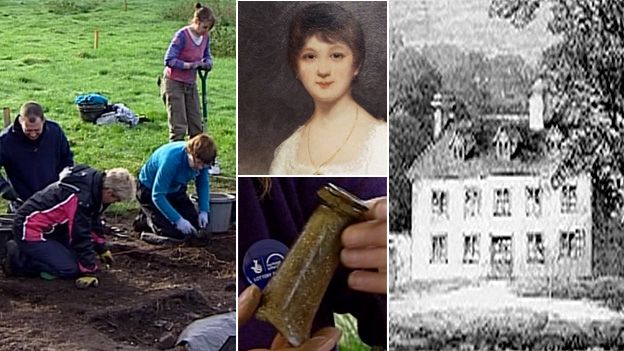Unlocking secrets from Jane Austen's Steventon home
- Published

Finds from an archaeological dig at the birthplace of Jane Austen are beginning to reveal details of the author's early home life.
Volunteers excavated the field in Steventon in the Hampshire countryside in 2011 where the village's old rectory once stood.
The process of cleaning and interpreting the finds has yielded a clearer idea of what the house looked like and even what the family ate their meals off.
Austen was born in the village where her father was rector in 1775, and lived there for 25 years. It was there she drafted stories which were eventually published as Pride and Prejudice and Sense and Sensibility.
The house was demolished soon after her family moved to Bath.
'Nerve wracking'
The land returned to meadow but was never ploughed, raising the prospect of a successful dig for any remains or household artefacts.
Contemporary records and an initial geophysical scan of the ground was used to identify the exact position of the house. No visible signs of the building remained, aside from a blocked-off well.
Project director Debbie Charlton, of Archeo Briton, said: "It was nerve wracking when the first bricks appeared. We weren't 100% sure we were in the right place when we started."
One mystery has already been solved. Although the original shape of the building was recorded on a local map in the early 1800s, historians have never been sure which contemporary illustration of the house was more accurate.
"We've been able to see its size, exact location and place it more precisely into the landscape," said Ms Charlton.
The unearthed foundations show the house to be most like the one published in the memoirs of Austen's nephew. One painted later by another family member showing a picket fence has now been discounted.
Maureen Stiller, of the Jane Austen Society of Great Britain, said fans had long wanted to know more about the house in which their heroine was born.
"Jane Austen devotees are eager to see the places Jane knew or wrote about - it's about being able to visualise it when you are standing there," she said.
1,000 nails
With 500 shards of pottery alone to be washed, catalogued and interpreted, Ms Charlton is still in the midst of completing a "giant jigsaw puzzle" about the house's history.
The volunteers unearthed small pieces of broken china, storage jars, wine glass stems, clay pipes dating from before the Austens' residency, as well as more than 1,000 nails.
Nails give clues to the type of beams used in the house, while plates with the famous blue willow pattern show what the family would have eaten off.
"They were absolutely from Jane Austen's time and shows they were up there following fashions in china," said Ms Charlton.
While Austen's books reflect the glamour of regency society, the initial studies of the finds of pottery and storage utensils have revealed a more down-to-earth existence of the family.
Ms Charlton said: "They certainly weren't well off. They... were very much part of the village life. It was a working house and they took care of themselves.
"You get the impression they were a hard-working family - they were into the good life."
"Her stories were not what her own life was like. Whereas Pride and Prejudice is about rich gentlemen and young ladies, her life seems more normal.
"She must have been drawing on her imagination and experiences of visiting and meeting people, rather than her own, more day-to-day existence. It starts you off on a trail, where was she gathering all these experiences? It's got everyone talking and thinking."
Ms Stiller said: "You have to think about where she was living. This was an isolated village, roads were impassable in bad weather. I find it astonishing she had such a big social life."
It is hoped the finds will go on display at Basingstoke's Willis Museum when a full study has been completed. A detailed report on the dig is due to be released later in 2013.
- Published16 December 2011
- Published5 December 2011
- Published23 December 2011